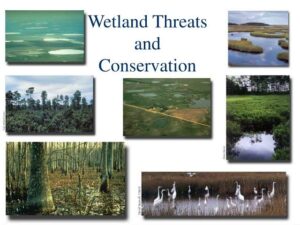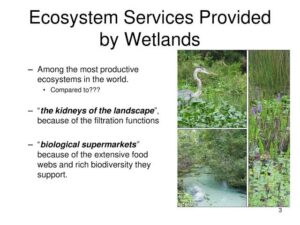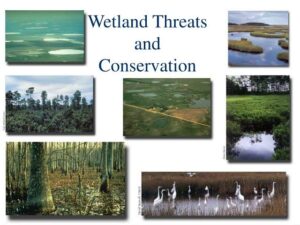Back to: Botany 300 Level
Hello, dear Afrilearn scholar! I hope you’re having a wonderful day and are ready to dive into an exciting and important topic. Today, we’re going to look at something that affects us all—the threats to wetland vegetation and the importance of their conservation. Wetlands are vital ecosystems, as we’ve already learned, but unfortunately, they are under threat from various human activities. The good news is that we can do something about it! Let’s explore how we can protect these essential habitats and ensure they continue to thrive for generations to come.
Threats and conservation of wetland vegetation
Why Are Wetlands and Wetland Vegetation Important?
Before we jump into the threats, let’s remind ourselves of just how important wetlands and their vegetation are for our environment. Wetland vegetation plays several vital roles:

Support for biodiversity: Wetland plants provide food, shelter, and breeding grounds for a wide range of species.
Water purification: Wetlands filter pollutants, excess nutrients, and sediments, improving the quality of water.
Flood control: Wetlands help absorb excess rainwater, reducing the risk of floods in surrounding areas.
Carbon storage: Wetland plants store carbon, helping to reduce the effects of climate change.
As you can see, wetland vegetation is crucial for the health of both the environment and human communities. However, these areas face many challenges.
Threats to Wetland Vegetation
Wetland ecosystems are facing severe threats from both human and natural activities. These threats can lead to the destruction of wetland vegetation, which, in turn, disrupts the entire ecosystem. Let’s take a look at some of the major threats to wetland vegetation:
1. Urban Development and Land Conversion
As cities and towns expand, wetlands are often drained and converted into agricultural lands, industrial sites, or residential areas. This destroys the wetland vegetation, as the natural habitat is cleared to make way for buildings and roads.
Example: In many parts of Nigeria, wetlands are drained to create space for farms and housing estates. This causes a loss of vital plants like water lilies and cattails, which are important for local wildlife.
2. Pollution
Wetlands are frequently polluted by industrial waste, sewage, agricultural runoff, and oil spills. These pollutants harm wetland vegetation, making it harder for plants to thrive. High levels of nutrients, like nitrogen and phosphorus, can lead to eutrophication, which causes harmful algal blooms that suffocate aquatic plants and disrupt the entire ecosystem.
Example: The Niger Delta is heavily affected by oil spills that damage mangrove forests and other wetland plants, threatening local biodiversity and the livelihoods of nearby communities.

3. Climate Change and Rising Temperatures
Climate change is causing rising temperatures, altered rainfall patterns, and sea-level rise. These changes can result in droughts, flooding, or increased salinity in wetland areas, which affect the growth and survival of wetland vegetation. As the climate continues to change, these impacts may become more severe.
Example: In coastal wetlands, rising sea levels can cause the salinity of the water to increase, which negatively impacts plants like mangroves that are not adapted to higher salt concentrations.
4. Invasive Species
Invasive plant species are non-native plants that are introduced into wetlands, often by human activities. These species can outcompete and replace native wetland plants, reducing biodiversity. Some invasive species can even alter the soil structure or water chemistry, further harming the native vegetation.
Example: The water hyacinth, a floating plant that is not native to Africa, has spread rapidly in many wetlands, including the Lake Victoria basin. It chokes out native plants and disrupts local water systems.
5. Over-exploitation of Wetland Resources
Wetlands provide many valuable resources, such as firewood, medicinal plants, fish, and timber. However, over-exploitation of these resources can lead to the destruction of wetland vegetation. When plants are over-harvested, or if fishing practices are unsustainable, the wetland ecosystem becomes unbalanced.
Example: In the Niger Delta, mangroves are often harvested for firewood and timber, which reduces the available habitat for fish and other species that depend on the mangrove ecosystem.
Conservation of Wetland Vegetation
Now that we know the threats, let’s talk about conservation strategies to protect wetland vegetation and ensure these ecosystems can continue to provide their important services.
1. Protected Areas and Reserves
One of the most effective ways to conserve wetlands is to establish protected areas and reserves. These areas are legally protected from development, pollution, and over-exploitation, allowing wetland vegetation to thrive without human interference.
Example: The Lekki Conservation Centre in Lagos is a wetland reserve that protects the unique vegetation of the coastal region. By limiting human activity, the area helps preserve important plant species and supports local biodiversity.

2. Sustainable Resource Management
It’s important to manage wetland resources in a way that ensures they remain available for future generations. This includes sustainable practices such as controlled harvesting of plants and fish, as well as using wetland resources in a way that doesn’t deplete them.
Example: In the Niger Delta, communities are working on sustainable mangrove harvesting practices to protect these valuable ecosystems. This involves careful management of the mangrove forests to prevent over-exploitation.
3. Restoration of Degraded Wetlands
Restoration projects aim to rebuild wetlands that have been degraded or destroyed by human activities. This may involve planting native vegetation, cleaning up pollution, and reintroducing water flow to areas that have been drained.
Example: The Epe Mangrove Restoration Project in Lagos State aims to restore mangrove forests that have been damaged by over-exploitation and urbanisation. This helps to protect local biodiversity and restore the natural ecosystem.
4. Education and Awareness
Raising awareness about the importance of wetland conservation is key to protecting these ecosystems. Communities, governments, and organisations need to work together to educate the public about the importance of wetlands and the need for sustainable management.
Example: In Nigeria, organisations like The Nigerian Conservation Foundation (NCF) are working to educate the public about the benefits of wetlands and the importance of protecting them for the future.
Summary
Wetlands and wetland vegetation face many threats, including:
Urban development and land conversion that destroys wetland habitats.
Pollution, especially from oil spills and agricultural runoff, that harms wetland plants.
Climate change and rising temperatures, which disrupt the conditions necessary for wetland vegetation to thrive.
Invasive species, which outcompete native plants.
Over-exploitation of wetland resources, such as timber and fish.
However, there are several conservation strategies we can use to protect wetland vegetation, such as:
Establishing protected areas and reserves.
Promoting sustainable resource management.
Implementing restoration projects.
Raising education and awareness.
By taking these actions, we can ensure that wetlands continue to provide the vital services they offer, including supporting biodiversity, purifying water, and protecting coastal areas from erosion.
Evaluation
- What are some of the major threats to wetland vegetation?
- How can protected areas help conserve wetland vegetation?
- Why is it important to practice sustainable resource management in wetland areas?
- What role does education play in wetland conservation?
- How can restoration projects help revive degraded wetlands?
Great job today! You’ve done an amazing job learning about the threats to wetland vegetation and how we can conserve these precious ecosystems. Keep up the great work, and remember—every effort, no matter how small, counts towards preserving our natural world. I’m so proud of you, and I can’t wait to see you in our next lesson. Keep shining, and stay curious!
